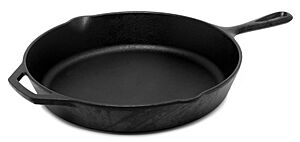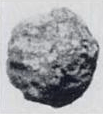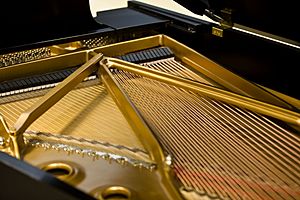Cast iron facts for kids
Cast iron is a type of metal that is mostly iron, mixed with a lot of carbon (more than 2%). Think of it like a special metal mix, called an alloy. The amount of carbon and other things in it changes how it looks when it breaks. For example, "white cast iron" has tiny bits that make cracks go straight through. But "grey cast iron" has tiny flakes that make cracks bounce around, creating many new cracks as it breaks.
Besides iron, cast iron usually has about 2% to 4% carbon and 1% to 3% silicon. If a metal has less carbon than this, it's called steel. Cast iron melts at a lower temperature than pure iron, usually between 1150 to 1200 degrees Celsius (about 2100 to 2200 degrees Fahrenheit). This makes it easier to melt and pour into shapes.
Cast iron can be quite brittle, meaning it can break easily if bent or hit hard, except for a special type called malleable iron. But it's very strong when you push on it (in compression). Because it melts easily, flows well, and is good at being shaped, cast iron is used for many things. You can find it in pipes, parts of machines, and even in car parts like engine blocks. It also doesn't rust easily, which is a big plus!
The first cast iron objects were found in China, dating back to the 5th century BC. People in ancient China used it for war, farming tools, and buildings. Later, in the 15th century, cast iron became important in Europe for making cannons. The very first bridge made of cast iron was built in the 1770s by Abraham Darby III. It's still famous today as The Iron Bridge. Cast iron is also used in buildings.
Grey cast iron is great at moving heat around. This is why it's often used to make cookware like frying pans.
Contents
A Look Back: The History of Cast Iron
The oldest cast iron items we know of were found in China, in a place called Jiangsu. They date back to the 5th century BC. Cast iron is strong when you press on it, but it's not good if you need something that can bend or have a super sharp edge.
In ancient China, people poured melted cast iron into molds to make things like plow blades, pots, weapons, and even tall towers called pagodas. Even though steel was better for some things, cast iron was cheaper. So, it was used more often for tools, while steel or wrought iron was saved for weapons.
Cast iron didn't arrive in the Western world until the 15th century. One of its first big uses there was for making cannons and cannonballs. Henry VIII started making cannons in England. Soon, English iron workers learned how to make cast iron cannons using blast furnaces. These cannons were heavier than the bronze ones used before, but they were much cheaper. This helped England build a stronger navy.
The idea of using cast iron likely came from China. Travelers in the 13th century noted iron industries in places close to the Silk Road, which was a trade route from China.
In 1707, a man named Abraham Darby I found a way to make cast iron pots and kettles thinner and cheaper. This made his company, Coalbrookdale, very successful at selling pots.
Cast iron also became important for the new steam engines invented by Thomas Newcomen. The cylinders for these engines were first made of brass, which was expensive. Cast iron was much cheaper. A man named John Wilkinson was a big fan of cast iron. He made many of the engine cylinders for James Watt's improved steam engines.
Cast Iron Bridges: Building with Metal
Using cast iron for big structures like bridges started in the late 1770s. This is when Abraham Darby III built the Iron Bridge. Before this, cast iron was only used for smaller parts. Other inventors, like Thomas Paine, also found new ways to use it.
As the Industrial Revolution grew, cast iron bridges became common. Thomas Telford used cast iron for his bridge at Buildwas and for canal aqueducts (bridges that carry water for canals). Two famous aqueducts, the Chirk Aqueduct and the Pontcysyllte Aqueduct, are still used today.
Early railways also used cast iron bridges. However, problems started to appear. In 1847, a bridge over the River Dee in Chester collapsed. This happened because a train put too much weight on the middle of the bridge. Many similar bridges had to be taken down and rebuilt, often using wrought iron instead. Engineers learned that cast iron is very strong when you push on it (in compression), but it's weak when you pull on it (in tension). This is like how stone is strong when pushed, but not when pulled.
The best way to use cast iron for bridges was to build them as arches. In an arch, all the weight pushes down, putting the cast iron in compression, where it is very strong. Wrought iron, on the other hand, is strong when pulled and can bend without breaking easily.
Despite these lessons, cast iron was sometimes still used in ways that weren't safe. A big disaster happened in 1879 when the Tay Rail Bridge collapsed. Parts of the bridge that held it together broke because they were made of cast iron and were not designed well. After this, the replacement bridge was built using stronger wrought iron and steel.
More bridge collapses happened later, leading to thousands of cast iron railway bridges being replaced with steel ones.
Images for kids
-
Model of a Han dynasty blast furnace blower.
See also
 In Spanish: Fundición de hierro para niños
In Spanish: Fundición de hierro para niños












